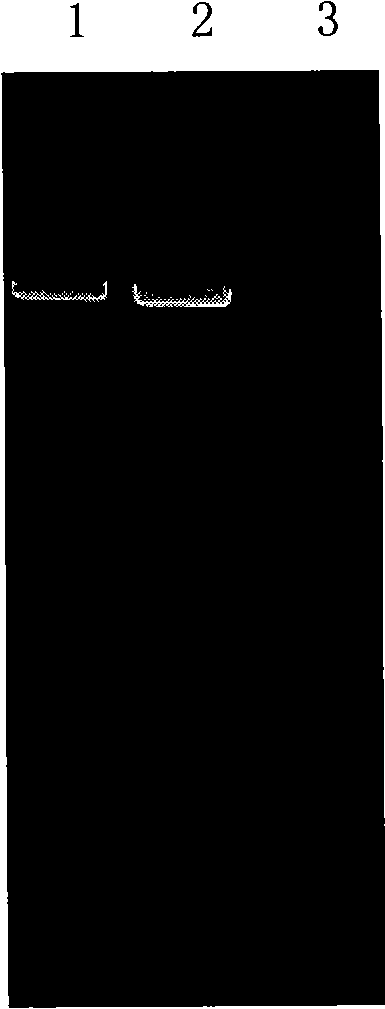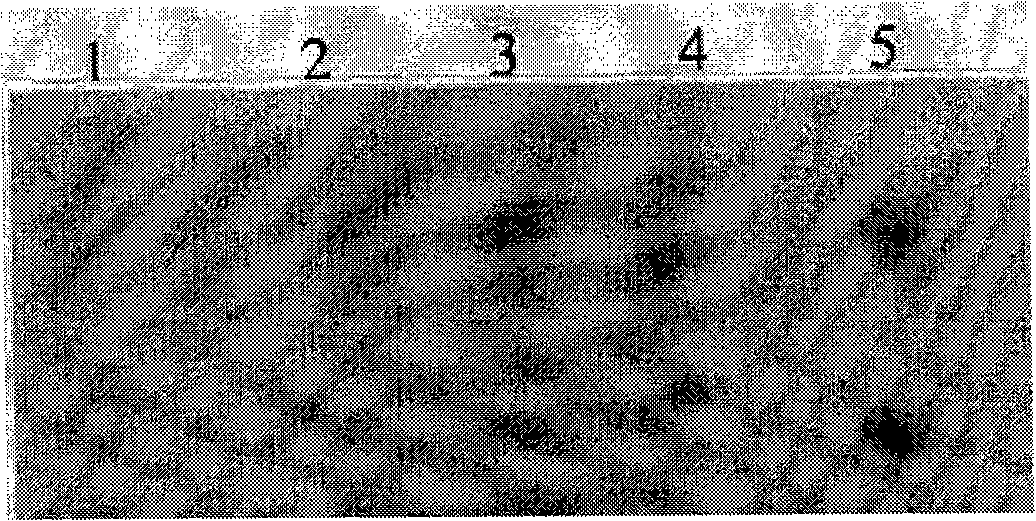Novel use of gene DCF1 related to neural stem cell differentiation
A neural stem cell and gene technology, applied in genetic engineering, plant genetic improvement, application, etc., can solve problems such as unreported functions
- Summary
- Abstract
- Description
- Claims
- Application Information
AI Technical Summary
Problems solved by technology
Method used
Image
Examples
Embodiment 1
[0014] Example 1: Construction and identification of bait plasmid pGBKT7-DCF1
[0015] The upstream and downstream primers of DCF1 were designed using Premier 5.0 software, and EcoRI and SalI restriction sites were introduced into the upstream and downstream primers, respectively. This pair of primers was synthesized by Shanghai Sangong. Using mouse brain cDNA as a template, the full-length cDNA of DCF1 was amplified with synthetic upstream and downstream primers, digested with EcoR I and SalI, and connected to the pGBKT7 vector that was also digested with EcoR I and SalI. Enzyme digestion, PCR identification, correct sequencing, see figure 1 . AH109(pGBKT7-DCF1) cannot grow in SD / -Trp / -His, and in the β-galactosidase activity filter copy analysis, the colonies remain white within 8 hours without turning blue, see figure 2 . It suggested that the pGBKT7-DCF1 plasmid did not activate the expression of the reporter gene itself. can be used in subsequent experiments.
Embodiment 2
[0016] Example 2: Screening of mouse brain cDNA library
[0017] The purified mouse brain cDNA library plasmid and pGBKT7-DCF1 bait plasmid were co-transformed into yeast cell AH109, and a total of 5.2X10 7 a transformant. Collect the yeast from the plate and titrate, the titer is 0.59X10 8 . Take 1.57X10 8 A total of 1820 clones were grown from 1 yeast strain on the SD / -Trp-Leu-His plate; these clones were picked onto the SD / -Trp-Leu-His-Ade plate with a toothpick to obtain 105 single clones. The expression of these 105 monoclonal β-galactosidase genes was detected by fliter-assay (blue and white screening), the results are as follows image 3 As shown, a total of 20 clones were blue (that is, expressed β-galactosidase gene), which were positive clones. The plasmids containing the pACT2 vector were extracted from the 20 positive clones obtained above, which were respectively electrotransformed into Escherichia coli DH5α for amplification, and the plasmids were extracte...
Embodiment 3
[0018] Example 3: Fluorescence colocalization verification of the interaction between DCF1 and ATP1B1
[0019] The upstream and downstream primers of ATPase, Na+ / K+transporting, and beta 1 polypeptide were designed using Premier 5.0 software, and EcoRI and BamHI restriction sites were introduced into the upstream and downstream primers, respectively. This pair of primers was synthesized by Shanghai Sangong. Using mouse brain cDNA as a template, use synthetic upstream and downstream primers to amplify the full-length cDNA of ATPase, Na+ / K+transporting, beta 1 polypeptide, EcoRI and BamHI double digestion, and connect to the same EcoRI and BamHI double digestion In the pDSRED2-C1 vector, enzyme digestion and PCR identification are correct, see Figure 4 . pDSRED2-ATP1B1 and pEGFP-DCF1 (for their construction methods, see Lei Wang, Jiao Wang, YiliuWu, Jie Wu, Shuya Pang, Rong Pan, Tieqiao Wen (2008) A Novel Function of dcflDuring the Differentiation of Neural Stem Cells In vitr...
PUM
 Login to View More
Login to View More Abstract
Description
Claims
Application Information
 Login to View More
Login to View More - R&D
- Intellectual Property
- Life Sciences
- Materials
- Tech Scout
- Unparalleled Data Quality
- Higher Quality Content
- 60% Fewer Hallucinations
Browse by: Latest US Patents, China's latest patents, Technical Efficacy Thesaurus, Application Domain, Technology Topic, Popular Technical Reports.
© 2025 PatSnap. All rights reserved.Legal|Privacy policy|Modern Slavery Act Transparency Statement|Sitemap|About US| Contact US: help@patsnap.com



